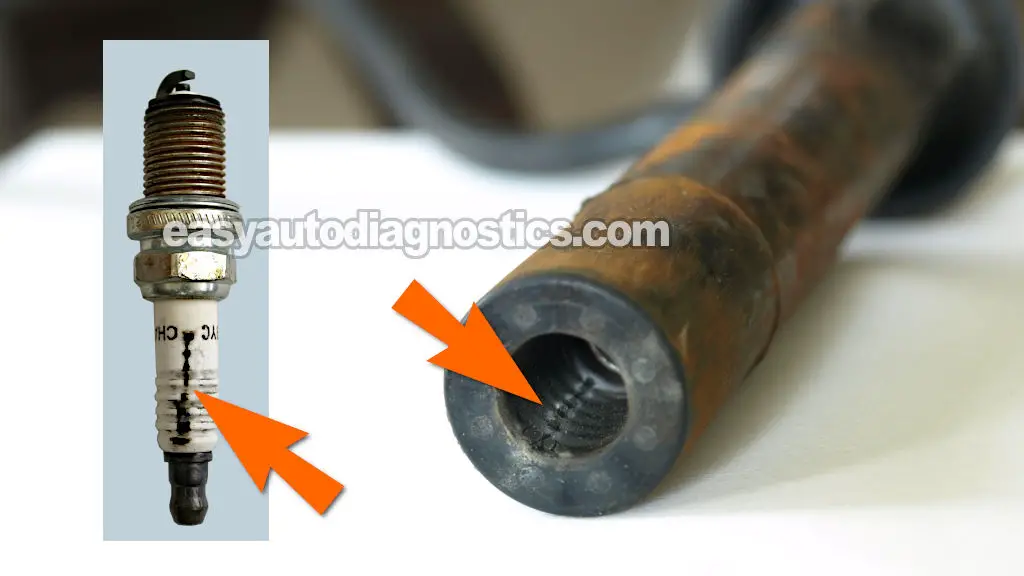TEST 7: Checking The Activation Signal For Coil B (Cylinders 2 & 3)

So far, you've verified two things:
- Spark plug wires for cylinders 2 and 3 didn't spark in TEST 1.
- The coil pack towers tied to those wires also didn't fire spark in TEST 4.
Now it's time to see if ignition coil B inside the coil pack —the one that fires spark for cylinders 2 and 3— is getting its activation signal from the PCM.
This signal travels on the light green with white stripe (LT GRN/WHT) wire, which connects to female terminal 3 of the coil pack's 3-wire connector.
We can easily check for this activation signal with a 12-Volt test light at female terminal 3.
NOTE: Make sure you use a standard 12-Volt test light that has an incandescent bulb. If you don't already have one, here's the one I recommend —you can pick it up here: Lisle 28400 Heavy Duty 12 Volt Test Light (Amazon affiliate link).
Alright, let's get to it:
- 1
Disconnect the ignition coil pack's 3-wire connector.
- 2
Clip the alligator lead of your 12V test light to the battery negative (-) post.
- 3
Probe female terminal 3 of the coil pack connector with the tip of the test light.
Confirm that terminal 3 actually connects to the LT GRN/WHT wire of the connector.
NOTE: Be careful not to damage the female terminal with the probe —if you do, you'll have to replace the connector. - 4
Have your helper crank the engine.
- 5
The 12V test light should flash ON and OFF the whole time the engine cranks.
NOTE: Don't worry about what the test light does before cranking the engine —whether it comes on or not. What matters is that it flashes while the engine is cranking.
OK, let's interpret your test result:
CASE 1: The 12V test light flashed ON and OFF the entire time the engine was cranking. This tells us the PCM is indeed providing an activation signal for ignition coil B.
If that's the case, you can conclude the coil pack is defective and needs replacement —provided you've already confirmed all of the following:
- Spark plug wires for cylinders 2 and 3 didn't spark (TEST 1).
- The coil pack towers for cylinders 2 and 3 also didn't spark (TEST 3).
- The activation signal for ignition coil B is present at terminal 3 (this section).
For the replacement coil pack, I suggest going with a trusted brand. Here are two I've relied on since I first started wrenching on cars —Standard Motor Products and Motorcraft:
- Standard Motor Products FD497T Ignition Coil (Amazon affiliate link).
- Motorcraft - IGN Coil DG536 (Amazon affiliate link).
CASE 2: The 12V test light DID NOT flash ON and OFF while the engine was cranking. Go back, recheck your connections, and try the test again.
If the test light still doesn't flash, ignition coil B is not getting its activation signal from the PCM.
This missing signal is usually caused by an open-circuit issue in the LT GRN/WHT wire somewhere between the coil pack connector and the PCM. Your focus should now shift to troubleshooting this missing signal and restore it to the circuit.
TEST 8: Checking Coil A And B Activation Signals

Up to this point, your tests confirm two things: first, all four spark plug wires aren't sparking (TEST 1), and second, the ignition coil pack is getting its IGN power feed (TEST 4).
In this next section, we're going to check if your Ford Escape or Mazda Tribute's PCM is actually providing the ignition coil activation signals to the coil pack. There are two separate signals to look for:
- Ignition coil A activation signal —this is the signal to fire spark to cylinders 1 and 4.
- Ignition coil B activation signal —this is the signal to fire spark to cylinders 2 and 3.
NOTE: To run this test, you'll need a standard 12-Volt test light with an incandescent bulb. If you don't already have one, this is the one I use and recommend: Lisle 28400 Heavy Duty 12 Volt Test Light (Amazon affiliate link).
These are the test steps:
- 1
Disconnect the coil pack's 3-wire connector.
- 2
Clip the alligator lead of your 12V test light to the battery negative (-) post.
- 3
Test terminal 1 (ignition coil A).
Probe female terminal 1 of the connector with the tip of the test light.
Verify that terminal 1 connects to the DK GRN/VIO wire.
NOTE: Be careful not to damage the female terminal with the probe —if you do, you'll have to replace the connector. - 4
Have your helper crank the engine. The test light should flash ON and OFF the whole time the engine cranks.
- 5
Test terminal 3 (ignition coil B).
Move the probe to female terminal 3 of the connector.
Verify that terminal 3 connects to the LT GRN/WHT wire. - 6
Have your helper crank the engine again. The test light should flash ON and OFF the whole time the engine cranks.
Let's find out what your test result means:
CASE 1: The 12V test light flashed ON and OFF the whole time the engine was cranking. This tells us both ignition coil activation signals are present (coil A and coil B).
At this point, you can conclude the coil pack is bad and needs to be replaced. Why? Because:
- In TEST 1, you confirmed none of the spark plug wires are sparking.
- In TEST 4, you confirmed the coil pack is getting its IGN power feed.
- In this test, you've confirmed the coil pack is receiving both activation signals from the PCM.
With all of these conditions met, the only thing left that can keep the engine from sparking is a failed ignition coil pack.
When buying the new coil pack, I suggest sticking with a known automotive brand. Here are two I don't hesitate to recommend —Standard Motor Products and Motorcraft:
- Standard Motor Products FD497T Ignition Coil (Amazon affiliate link).
- Motorcraft - IGN Coil DG536 (Amazon affiliate link).
CASE 2: The 12V test light DID NOT flash ON and OFF while the engine was cranking. This result means the coil pack isn't receiving either of its activation signals, so it can't fire spark to any cylinder.
That rules out the coil pack itself as the cause of the no-spark condition. Without those signals, even a brand-new coil pack won't spark. Your troubleshooting efforts should now shift to finding out why both signals are missing —most likely a bad crankshaft position (CKP) sensor. Your next step is to test the CKP sensor.
Other Things That Can Cause A Misfire

If you've confirmed all four cylinders are getting spark —and have ruled out the spark plug wires, coil pack, and spark plugs themselves as the cause of the rough idle or cylinder misfire on your 2.0L Ford Escape (or Mazda Tribute)— then here are a few other areas you'll want to check:
- Engine oil in the spark plug wells —These engines are known for valve cover leaks that let engine oil seep into the spark plug tube wells. When that happens, the plugs and wire boots end up sitting in oil. Over time, the oil cooks, forms carbon tracks, and those tracks cause misfires.
- Inspect the inside of the wire boots and the ceramic insulator of each spark plug. If you see carbon tracks (like in the photo above), they can't be cleaned off —you'll need to replace the affected parts. This is a case study on this particular type of problem:
- Low or uneven engine compression —A very common (but often overlooked) cause of misfires is poor compression in one or more cylinders. Make sure all four have good compression.
- Use the following tutorial to guide you through a compression test and, more importantly, how to interpret the results to pinpoint a weak cylinder causing the rough idle or misfire:
- Clogged or failed fuel injectors —If an injector is clogged or dead, that cylinder won't get enough fuel (or any fuel), and it's going to misfire. The good news is that on your Escape or Tribute's 2.0L engine, the injectors are fairly easy to test.
- One of the first things you can do is check their internal resistance with a multimeter. The following tutorial walks you through that process step by step:
- Intake manifold gasket leaks —The intake manifold seals to the cylinder head with rubber gaskets, and over time these gaskets harden and shrink. That creates vacuum leaks where the manifold meets the head, especially when the engine is cold.
- An intake manifold gasket vacuum leak will cause a rough idle, a misfire, and often a P0300 random misfire trouble code. Check carefully for vacuum leaks around the intake manifold's gasket area —this is a very common issue on these engines.
More 2.0L Ford Escape Diagnostic Tutorials
You can find a complete list of diagnostic tutorials for the 2.0L Ford Escape (Mazda Tribute) in this index:
Here's a small sample of the tutorials you'll find:
- How To Test The Starter Motor (2001-2004 2.0L Ford Escape).
- Oxygen Sensor Heater Test -P0135 (2001-2004 2.0L Ford Escape).
- How To Test The Fuel Injectors (2001-2004 2.0L Ford Escape).
- How To Test For A Blown Head Gasket (2001-2004 2.0L Ford Escape).

If this info saved the day, buy me a beer!


